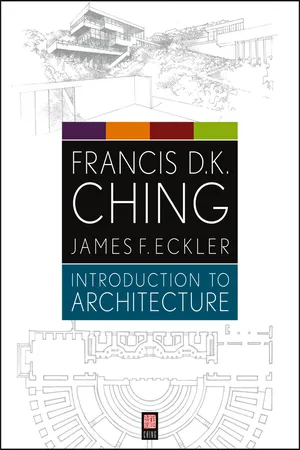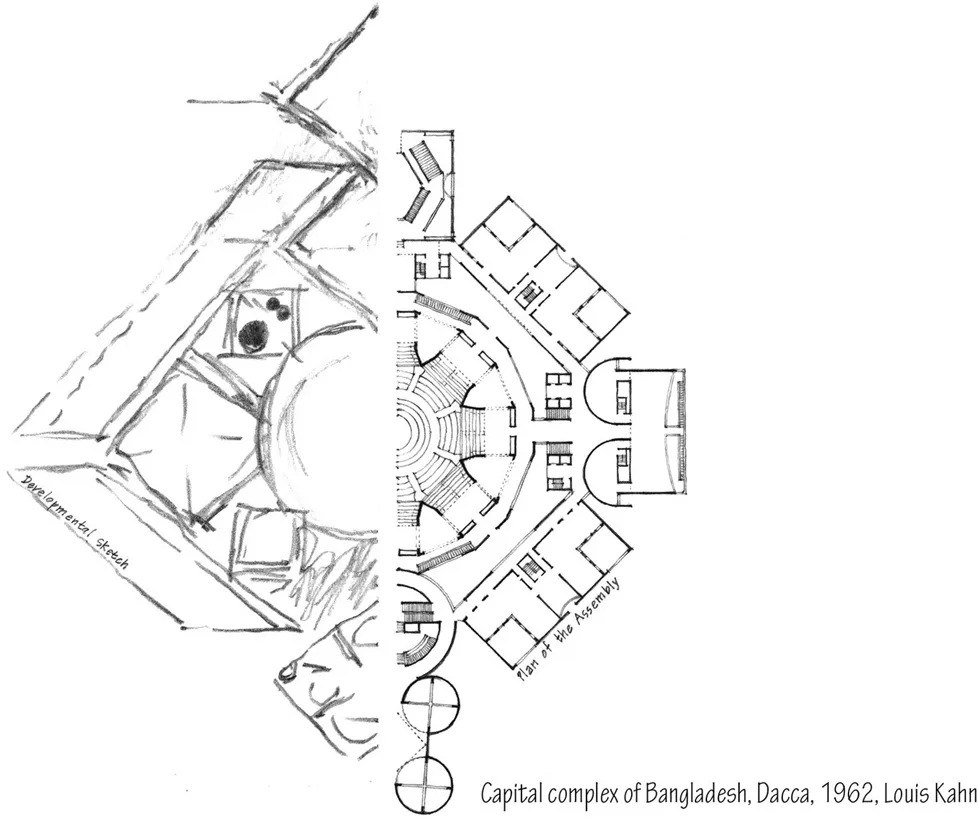
- English
- ePUB (mobile friendly)
- Available on iOS & Android
Introduction to Architecture
About this book
A survey of the built environment distills the work of legendary author and illustrator Francis D. K. Ching into a single volume
Introduction to Architecture presents the essential texts and drawings of Francis D. K. Ching for those new to architecture and design. With his typical highly graphic approach, this is the first introductory text from Ching that surveys the design of spaces, buildings, and cities. In an easy to understand format, readers will explore the histories and theories of architecture, design elements and process, and the technical aspects of the contemporary profession of architecture.
The book explains the experience and practice of architecture and allied disciplines for future professionals, while those who love the beauty of architecture drawing will delight in the gorgeous illustrations included.
- Overview of the issues and practices of architecture in an all-in-one introductory text
- Includes new chapters and introductory essays by James Eckler, and features more than 1, 000 drawings throughout
- Professor Ching is the bestselling author of numerous books on architecture and design, all published by Wiley; his works have been translated into 16 languages and are regarded as classics for their renowned graphical presentation
For those pursuing a career in architecture or anyone who loves architectural design and drawing, Introduction to Architecture presents a beautifully illustrated and comprehensive guide to the subject.
Frequently asked questions
- Essential is ideal for learners and professionals who enjoy exploring a wide range of subjects. Access the Essential Library with 800,000+ trusted titles and best-sellers across business, personal growth, and the humanities. Includes unlimited reading time and Standard Read Aloud voice.
- Complete: Perfect for advanced learners and researchers needing full, unrestricted access. Unlock 1.4M+ books across hundreds of subjects, including academic and specialized titles. The Complete Plan also includes advanced features like Premium Read Aloud and Research Assistant.
Please note we cannot support devices running on iOS 13 and Android 7 or earlier. Learn more about using the app.
Information
1
Introduction:
Object, Space, Building, City

What Is Architecture?

Artistic Discipline and Technical Profession

Creative Process and Construction Method

Intuitive and Academic

Episteme

- History
- Theory
- Human behavior
- Human perception


Techne



- Construction methods
- Material attributes
- Building technology
- Representation and communication (through drawing or model)
Design Thinking
Table of contents
- Cover
- Title page
- Copyright page
- Preface
- 1: Introduction: Object, Space, Building, City
- 2: The Beginnings of Architecture: Early History— from Ancient Times to the Renaissance
- 3: A Concise History: Architecture from the Renaissance to the Contemporary
- 4: Fundamentals of Architecture: Form
- 5: Fundamentals of Architecture: Space
- 6: Fundamentals of Architecture: Order
- 7: Elements of Architecture: Types, Systems, and Components That Inform Design
- 8: The Design Process: Tools and Techniques for Generating Ideas
- 9: Materials of Architecture: Their Qualities, Characteristics, and Behaviors
- 10: Methods of Construction: What Are the Implications of Construction Methods on Architectural Design?
- 11: Building Structure: Resisting the Forces That Act against Buildings
- 12: Building Systems: How Do Buildings Work?
- 13: Architectural Practice and Communication: What Are the Responsibilities of a Professional Architect?
- 14: Allied Disciplines: Interior Design
- 15: Allied Disciplines: Urbanism
- Glossary
- Index
- End User License Agreement